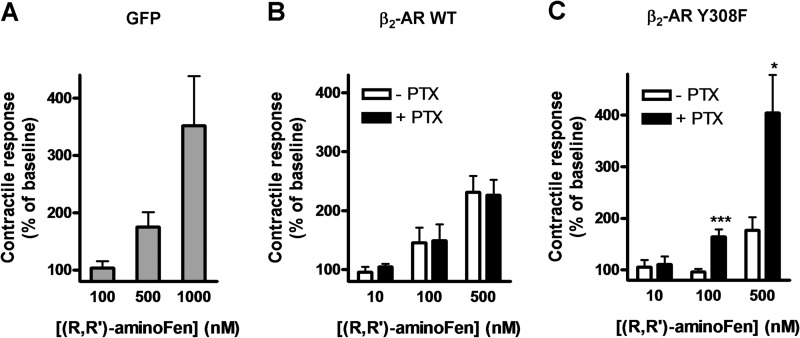FIGURE 5.
PTX increases the inotropic effect of (R,R′)-aminoFen in cardiomyocytes expressing β2-AR Y308F mutant but not in cardiomyocytes expressing WT human β2-AR. A, (R,R′)-aminoFen-stimulated contractile responses in β2-AR knock-out mouse cardiomyocyte adenoviral gene transfer GFP. Cardiomyocytes from β2-AR knock-out mice were infected with adeno-GFP and cultured for 24 h. Cells were paced under perfusion and subjected to (R,R′)-aminoFen (100, 500, or 1000 nm). Steady-state contractility before and after agonist stimulation was measured. B, (R,R′)-aminoFen-stimulated contractile responses in β2-AR knock-out mouse cardiomyocytes adenoviral gene transfer WT β2-AR in the presence or absence of PTX treatment. Cardiomyocytes from β2-AR knock-out mice were infected with adeno-β2-AR and cultured with or without PTX (0.75 μg/ml) for 24 h. Cells were paced under perfusion and subjected to (R,R′)-aminoFen (10, 100, or 500 nm). C, (R,R′)-aminoFen-stimulated contractile responses in β2-AR knock-out mouse cardiomyocyte adenoviral gene transfer β2-AR Y308F in the presence or absence of PTX treatment. Contractile responses are expressed as percentages of the basal contractility (mean ± S.E., n = 9–14 cells from 4 to 8 hearts for each data point). Concentration dependence of the (R,R′)-aminoFen-stimulated responses was verified (by two-way analysis of variance, p < 0.0001) for all datasets. *, p < 0.05; ***, p < 0.001 versus corresponding −PTX group.

